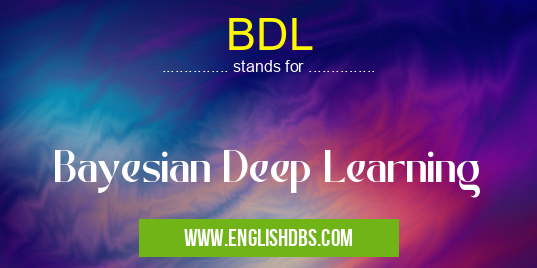What does BDL mean in EDUCATIONAL
Bayesian Deep Learning (BDL) is a powerful machine learning paradigm that combines the probabilistic framework of Bayesian statistics with the representational power of deep neural networks. This fusion enables the development of robust and interpretable models, providing a more comprehensive understanding of the underlying data.

BDL meaning in Educational in Community
BDL mostly used in an acronym Educational in Category Community that means Bayesian Deep Learning
Shorthand: BDL,
Full Form: Bayesian Deep Learning
For more information of "Bayesian Deep Learning", see the section below.
» Community » Educational
BDL Meaning in Community
Within the machine learning community, BDL has gained significant attention as a promising approach for addressing various challenges, including:
- Uncertainty quantification: BDL models provide principled mechanisms for quantifying the uncertainty associated with their predictions, enabling more informed decision-making.
- Interpretability: By incorporating probabilistic priors, BDL models improve their interpretability, allowing researchers and practitioners to gain insights into the model's behavior.
- Model selection: BDL provides a framework for comparing and selecting different models based on their predictive performance and complexity, facilitating the identification of the most suitable model for a given task.
BDL Full Form
The full form of BDL is Bayesian Deep Learning.
What Does BDL Stand For
BDL stands for:
- Bayesian: Incorporating probabilistic principles and modeling uncertainty.
- Deep: Utilizing deep neural networks for learning complex representations.
- Learning: Leveraging data to optimize model parameters and improve predictive capabilities.
Essential Questions and Answers on Bayesian Deep Learning in "COMMUNITY»EDUCATIONAL"
What is Bayesian Deep Learning (BDL)?
BDL is a machine learning approach that combines the principles of Bayesian inference with deep neural networks. It provides a probabilistic framework for deep learning models, enabling them to account for uncertainty in data and model parameters.
How does BDL differ from traditional deep learning?
Traditional deep learning models typically make point estimates of model parameters, assuming they are fixed. BDL, on the other hand, treats model parameters as random variables and infers their distribution from data. This allows BDL models to capture uncertainty in their predictions.
What are the benefits of using BDL?
BDL offers several advantages over traditional deep learning, including:
- Improved predictive performance: BDL models can account for uncertainty, leading to more accurate predictions and better generalization to unseen data.
- Reduced overfitting: BDL models can automatically regularize themselves, helping to prevent overfitting and improve model robustness.
- Interpretability: BDL provides a probabilistic framework that allows for better understanding and interpretation of model predictions.
What are the applications of BDL?
BDL has a wide range of potential applications in fields such as:
- Natural language processing: BDL can improve machine translation, text classification, and language modeling by accounting for uncertainty in text data.
- Computer vision: BDL can enhance object detection, image segmentation, and facial recognition by incorporating uncertainty into visual features.
- Healthcare: BDL can assist in medical diagnosis, disease prediction, and drug discovery by modeling uncertainty in patient data and clinical outcomes.
What are some challenges in BDL?
BDL faces several challenges, including:
- Computational cost: BDL models can be computationally expensive, especially for large datasets and complex models.
- Inference difficulty: Performing inference in BDL models can be complex and require advanced sampling techniques.
- Model interpretability: While BDL provides a probabilistic framework, it can still be challenging to interpret the learned distributions and their implications for model predictions.
Final Words: BDL is a transformative machine learning approach that brings together the strengths of Bayesian statistics and deep neural networks. It empowers researchers and practitioners with robust, interpretable, and uncertainty-aware models, enhancing their ability to solve complex problems in various domains. As the field of machine learning continues to advance, BDL is poised to play an increasingly significant role in driving innovation and shaping the future of artificial intelligence.
BDL also stands for: |
|
| All stands for BDL |
